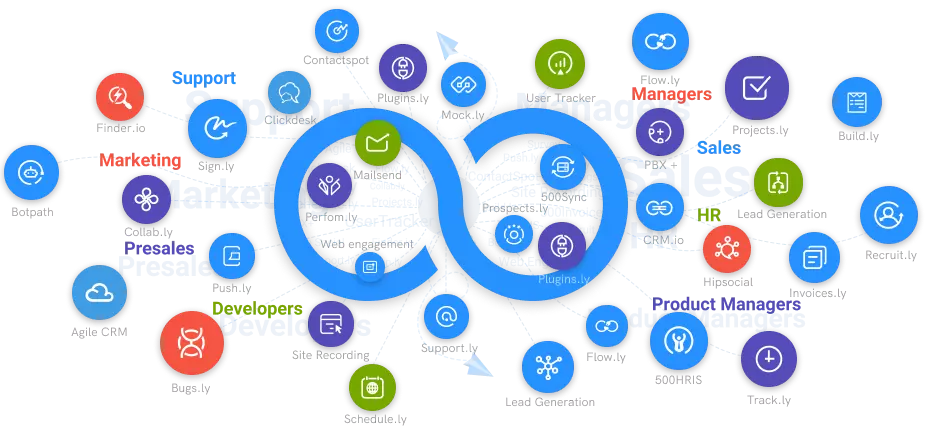Why Do Organizations Use Agile Project Management?
Understand about agile methodology in project management and how it is deployed in an organization.
#1
Plan, organize, track all your projects in one place
#2
Get a visibility over individual tasks in the form of kanban boards
#3
Track the project schedule using gantt chart and calendar view
#4
Create advanced workflows with powerful automations
#5
Track employee activities, and working hours using built-in time tracking software, Clockly
#6
Monitor activities using screen recorder on Windows, Mac and Linux devices
#7
Set S.M.A.R.T goals and achieve results
#8
Share files and collaborate with team through discussion boards
#9
Unbelievable pricing - the lowest you will ever find
#10
Everything your business needs - 50 apps, 24/5 support and 99.95% uptime
Agile project management is an iterative method of managing software development projects that emphasizes frequent releases and incorporating client input with each iteration. Agile project management approaches help software teams to improve development pace, collaboration, and the flexibility to adjust to market changes.
As the name implies, Agile enables teams to be more ready to shift direction and emphasis quickly. Software businesses and marketing firms are well aware of the tendency for project stakeholders to change from week to week. The Agile technique enables teams to re-evaluate their work and alter in specified increments to ensure that as the work and client landscape change, so does the team's emphasis. If you're new to Agile Project Management, it may appear to be a complex and difficult-to-manage method at first. However, whether you realize it or not, you are currently performing many of the tasks required by Agile. You'll be on your way to shorter development cycles and smaller, more frequent product releases with a few modifications.

The Agile method to project management, which was originally developed for software development, is increasingly being adopted by more than just IT teams. Marketers, colleges, the military, and even the automobile sector are looking to the Agile approach and other Agile frameworks to help them create creative products in difficult settings. Agile project management may benefit many firms, and it is simple to set up and use. When a choice is made in the software sector to construct or further enhance an existing technology, the ultimate result may be difficult to describe. Agile allows for uncertainty because of its ability to adjust project direction as work progresses into the future.
How is Agile Project Management Deployed at an Organization?
A company must be open to change in order to implement agile project management. The technique signifies a substantial shift in how an organization works and thinks, as well as how projects are executed and business is conducted. A readiness assessment may determine whether or not an organization is ready for change. The readiness assessment may provide an organization with an idea of how much time and effort agile implementation will require, what procedures will need to be in place, what resources and skillsets will be required, and what metrics will be used to track progress.
Deployment is often initiated by a single agile team, which will ultimately build agile standards and templates and disseminate the approach to subsequent teams across the enterprise. Its success depends on the correct team composition, adequate training to ensure that the pilot team understands the new approach and leadership sponsorship. Leadership must ensure that agile thinking gets ingrained in the culture. It must also be there to help early teams overcome roadblocks, which involves being helpful and maintaining frequent contact.
With project management software fully and successfully deployed, organizations can expect a greater focus on customer needs and wants, which equates to a rise in customer satisfaction. Organizations post-agile tend to experience an increase in sales and revenue while also reducing waste. They’ll see an improvement in collaboration, organizational flexibility, and adaptation to change, as well as more innovation. They can also expect improved morale, productivity, and better quality products. Team communication and teamwork will improve.

Teams fix faults more quickly, resulting in fewer project overruns. The risk may increase slightly as the business moves quicker, but it is better positioned to detect, deal with, and minimize those risks. Because of the improved flexibility, teams can manage and alter priorities more quickly. Organizations of all sizes are starting to realize what it takes to keep up in today's economy, which is driving to widespread adoption of agile project management. Community colleges may provide training and implementation for agile project management. Community colleges can assist with the teaching or certifications required for agile projects to flourish, whether the business is new to the technique or would like to see wider adoption.
The Agile Methodology is one of the most rapidly developing techniques that software development firms have recently adopted. The Agile technique has been shown to be quite beneficial in supporting businesses in developing profitable products. This is mostly due to Agile's emphasis on cooperation and the significance it places on client happiness. Another reason Agile projects are so effective is the creation of project roadmaps and their constant evolution in response to changing consumer demands.
Agile methodologies provide frameworks for businesses to follow in order to accomplish unlimited projects efficiently. The framework lists all of the project's demands and requirements, and all projects go forward smoothly. When compared to the standard waterfall technique, this is a far superior form of Project Management. The waterfall technique did not account for changes in the market and competition, as well as changing customer needs. This put developers at a significant disadvantage and frequently resulted in project failure. When businesses began to adopt an Agile strategy, they were able to keep up with shifting market trends and swiftly adjust to them. This aided them in developing items that were in high demand in the market. As a result, the Agile methodology has become a very popular strategy in the software development area.
Another reason why many firms want to employ the Agile methodology in their teams is the increased efficiency that comes with using Agile tools. Agile technologies make it easier to break down difficult jobs into smaller chunks that the team can work on.
Conclusion
Agile approaches assist team members in remaining motivated. The short iterations provide results rapidly, allowing team members to see the real functional product. This helps kids keep focused on the main objective since there is clear evidence of their success. This incentive significantly boosts the team's productivity. Along with verifiable progress, other features of Agile adoption, such as clarity of product vision and goals, clear allocated timescales, efficient work assignment, and more, aid in enhancing team member productivity.





